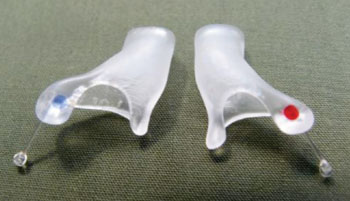Custom Ear Inserts Treat TMJ Pain and Dysfunction
By HospiMedica International staff writers
Posted on 26 Aug 2014
Innovative inserts take advantage of anatomical functional changes to provide a unique near-field treatment for temporomandibular joint (TMJ) disorders.Posted on 26 Aug 2014
The TMJ NextGeneration system consists of two custom-made ear inserts that are designed to be up to 20% larger in their dynamic geometry than the ear canal (when in a closed-jaw position). The minor change in the volume of the ear canal space created by the inserts is believed to apply subtle pressure against the walls of the ear canal, and by proximity to the TMJ and surrounding muscle and nerve tissue. This subtle pressure encourages the patient to return to the open-bite position, thus minimizing the tendency to clench the jaw and tense the surrounding muscles.

Image: The TMJ NextGeneration custom-made ear inserts (Photo courtesy of TMJ Health).
The ear inserts are made from a cast molding. When in place, the devices rest in the outer part of the ear canal, held in place by small retraction posts that allow for easy removal and placement by the patient. When in place, the inserts are practically invisible to view. In a three-month clinical study, patients wearing the devices experienced a significant reduction in the pain and dysfunction associated with TMJD, to an extent at least as much as that experienced by patients wearing a bite splint. The TMJ NextGeneration is a product of TMJ Health (Farmington Hills, MI, USA).
“TMJD has often been treated with bite splints, which are plastic mouthpieces that fit over the upper or lower teeth to prevent them from coming together and reduce the amount of clenching or grinding,” said Roger Wixtrom, PhD, president of LSCI (Springfield, VA, USA), a company specializing in the safety evaluation of medical products. “While bite splints have helped to reduce pain associated with TMJD, there are drawbacks with these devices. For example, they cannot be worn while eating and they can also affect speech, and as such are typically only worn at night while sleeping.”
TMD is a symptom complex rather than a single condition, and it is thought to be caused by multiple poorly understood factors; disagreements abound as to the relative importance of these factors with each other. Common symptoms include pain or tenderness in the face, jaws, neck, and shoulders; limited ability to open the mouth; intermittent jaw locks in open- or closed-mouth position; clicking, popping, or grating sounds in the jaw joint; difficulty chewing or a sudden uncomfortable bite; swelling on the side of the face; toothache; and tinnitus. Common treatments used include occlusal splints, psychosocial interventions, and analgesics.
Related Links:
TMJ Health














